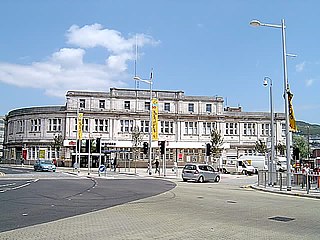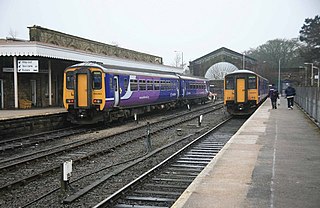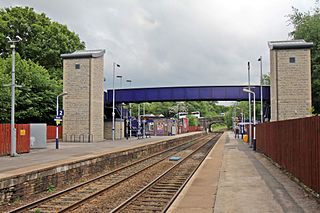
Manchester Piccadilly is the principal railway station in Manchester, England. Opened as Store Street in 1842, it was renamed Manchester London Road in 1847 and became Manchester Piccadilly in 1960. Located to the south-east of Manchester city centre, it hosts long-distance intercity and cross-country services to national destinations including London, Birmingham, Nottingham, Glasgow, Edinburgh, Cardiff, Bristol, Exeter, Plymouth, Reading, Southampton and Bournemouth; regional services to destinations in Northern England including Liverpool, Leeds, Sheffield, Newcastle and York; and local commuter services around Greater Manchester. It is one of 19 major stations managed by Network Rail. The station has 14 platforms: 12 terminal and two through platforms. Piccadilly is also a major interchange with the Metrolink light rail system with two tram platforms in its undercroft.

Manchester Oxford Road railway station is a railway station in Manchester, England, at the junction of Whitworth Street West and Oxford Street. It opened in 1849 and was rebuilt in 1960. It is the second busiest of the four stations in Manchester city centre.

Sheffield station, formerly Pond Street and later Sheffield Midland, is a combined railway station and tram stop in Sheffield, England; it is the busiest station in South Yorkshire. Adjacent is Sheffield station/Sheffield Hallam University Sheffield Supertram stop. In 2017–18, the station was the 43rd-busiest in the UK and the 15th-busiest outside London.

Crewe railway station is a railway station in Crewe, Cheshire, England. It opened in 1837 and is one of the most historically significant railway stations in the world.

Leeds railway station is the mainline railway station serving the city centre of Leeds in West Yorkshire, England. It is the fourth-busiest railway station in the UK outside London. It is located on New Station Street to the south of City Square, at the foot of Park Row, behind the landmark Queens Hotel. It is one of 20 stations managed by Network Rail.

Stockport railway station in Stockport, Greater Manchester, England, is 8 miles south-east of Manchester Piccadilly on the West Coast Main Line to London Euston.

Swansea railway station serves the city of Swansea, Wales. It is 186 miles 7 chains (299 km) measured from London Paddington on the National Rail network.

Blackpool North railway station is the main station serving the seaside resort of Blackpool in Lancashire, England. It is the terminus of the main Blackpool branch line and is 17+1⁄2 miles (28 km) northwest of Preston.

Manchester Airport station is a railway, tram, bus and coach station at Manchester Airport, England which opened at the same time as the second air terminal in 1993. The station is 9+3⁄4 miles (15.7 km) south of Manchester Piccadilly, at the end of a short branch from the Styal Line via a triangular junction between Heald Green and Styal stations. Manchester Metrolink tram services were extended to the airport in 2014 and operate to Manchester Victoria.

Chinley railway station serves the village of Chinley in Derbyshire, England. The station is 17+1⁄2 miles (28.2 km) south east of Manchester Piccadilly, on the Hope Valley Line from Sheffield to Manchester. It is unstaffed and is managed by Northern Trains.

Buxton railway station serves the Peak District town of Buxton in Derbyshire, England. It is managed and served by Northern. The station is 25+3⁄4 miles (41.4 km) south east of Manchester Piccadilly and is the terminus of the Buxton Line.

Sankey railway station, also known as Sankey for Penketh, is a railway station in the west of Warrington, Cheshire, England, serving the Great Sankey, Penketh and Whittle Hall areas of the town. The station, and all trains serving it, are operated by Northern Trains. It is designated by English Heritage as a Grade II listed building.

Gowerton railway station serves the village of Gowerton, Wales. It is located at street level at the end of Station Road in Gowerton 5+1⁄2 miles (8.9 km) west of Swansea. The station is unmanned but has a ticket machine, shelters on each platform and live train running information displays.

The Pines Express was a named passenger train that ran daily between Manchester and Bournemouth in England between 1910 and 1967.

Marple railway station is on the Hope Valley Line and serves Marple, in the Metropolitan Borough of Stockport, Greater Manchester, England. It is 8.9 miles (14.3 km) south-east of Manchester Piccadilly. The station, opened in 1865 by the Manchester, Sheffield and Lincolnshire Railway, was demolished and rebuilt in 1970. It is managed and served by Northern Trains, who provide two trains per hour in each direction.

Belle Vue railway station serves the area of Belle Vue, Manchester, England.

Ardwick railway station in Ardwick, Manchester, England, is about one mile (1.5 km) south-east of Manchester Piccadilly, in an industrial area of east Manchester. Plans to close the station permanently were scrapped in 2006 due to increasing activity in the area. The station has just one train in each direction calling on Monday to Friday in the winter 2019–20 timetable. These trains have additionally called at the station on Saturdays from May 2018.

Northwich railway station serves the town of Northwich in Cheshire, England. The station has two platforms and is located on the Mid-Cheshire line 28+1⁄4 miles (45.5 km) southwest of Manchester Piccadilly.

Altrincham Interchange is a transport hub in Altrincham, Greater Manchester, England. It consists of a bus station on Stamford New Road, a Northern Trains-operated heavy rail station on the Mid-Cheshire Line, and a light rail stop which forms the terminus of Manchester Metrolink's Altrincham line. The original heavy rail element of the station was opened by the Manchester, South Junction and Altrincham Railway as Altrincham and Bowdon railway station in April 1881, changing to Altrincham railway station in May 1974. The Metrolink element opened in June 1992. The Interchange underwent a complete redevelopment, at a cost of £19 million, starting in mid-July 2013. The new bus station opened officially on 7 December 2014.

Hayfield railway station was the terminus of the 3 mi (4.8 km) Hayfield branch from New Mills Central station in Derbyshire, England.


























